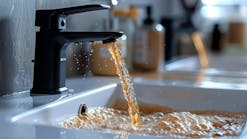As water resources become scarcer, municipalities across the country are looking for ways to conserve water and reduce pollution. The Milwaukee Metropolitan Sewerage District (MMSD) got the community involved by introducing rain barrels, an inexpensive method that manages pollution by reusing rainwater.
The rain barrel concept is simple: connect a 55-gal barrel to a downspout to catch and store rainwater, then reuse it to water a lawn or garden. “The use of rain barrels is making a comeback as a ‘green’ and environmentally friendly way to not only maintain your lawns and gardens, but to wash your car, windows or pets,” said Jaime Staufenbeil, director of MMSD’s rain barrel program. “Best of all, rain barrels help reduce water pollution and protect our rivers and lakes.”
A New Initiative
Starting in 2005, MMSD started a program to increase awareness of rain barrels and their many benefits as a part of Every Drop Counts, a campaign by the district that aims to educate the community about what it can do to protect water resources.
For barrel construction, the district worked with the Milwaukee Community Service Corps (MCSC), a non-profit vocational training organization for young adults. The MCSC constructs the rain barrels from recycled soda syrup containers that MMSD gets from various companies, making them environmentally friendly from the start. “Some of the barrels would have gone to landfills, so it’s great to be able to find another use for them,” Staufenbeil said.
The district also partnered with retail and nonprofit organizations to both promote rain barrel use and provide plenty of locations for homeowners to purchase them. Today, the barrels are available at 20 locations that range from municipalities to grocery stores to the Milwaukee County Zoo. “For the first few years of the program, we limited sales to people in the MMSD service area,” Staufenbeil said. “Since then we have opened up sales to anyone who wants to buy one at the 20 locations in the Milwaukee area.” Although the district does not track how many barrels are currently in the service area, it has sold more than 15,000 since 2005, she said.
How It Works
Each of the 3-ft-tall, 55-gal hard plastic barrels, which cost around $45 plus tax, comes outfitted with a 3-in. adaptor to connect to a downspout, an overflow valve and a brass spigot for easy connection to a hose. The set also includes a produce bag, which can be placed over a downspout to catch any debris before it enters the barrel.
Installation is easy—homeowners cut their downspout with a hacksaw at the proper height and connect the adaptor. MMSD recommends placing the barrel on concrete blocks or pavers to help increase water pressure. Once in place, a hose can be connected to the spigot for easy access to the water for watering or washing.
The low-maintenance system does require some winterizing in cold areas. Since freezing water could cause the barrels to crack, homeowners should either store them for the winter or turn them upside down so no water can collect in them. Temporary tubing, available at hardware stores, should be connected to the cut-off downspout to direct any rainwater or snowmelt away from the house.
Some considerations are necessary when installing a rain barrel, however. In areas where downspouts are connected to the sewer system, it may be illegal to disconnect them, so homeowners should check with their municipality before cutting them. And some downspouts may not fit the standard adaptor—downsizers are available at many hardware stores, however.
Community Benefits
Barrel users will see a quick return on investment for their rain barrels. By using the collected rainwater to water their lawns or gardens, or wash cars or windows, homeowners easily save money on water bills.
MMSD found that the rain barrels also provide another function: an art canvas. Most barrels come in plain blue or white, but many homeowners have personalized them with latex paint decorations.
“We have found that homeowners like to add a little personality and originality to their barrels by painting them,” Staufenbeil said. “The barrels themselves are an interesting talking point, but adding a little paint to them makes them even more of a conversation point.”
Painted barrels have become a fundraising option for the community as well. “We often donate barrels to local schools, church groups and environmental organizations to be painted and auctioned off to raise money for these organizations,” she said. One barrel on MMSD’s website, painted by students at the Downtown Montessori Academy, raised more than $400 at the school’s annual auction event.
Environmental Benefits
The simple systems have serious environmental benefits as well. “Nearly everything we do in our watersheds impacts the quality of creeks, streams, rivers and lakes in those watersheds,” Staufenbeil said. “Managing water where it falls, with a rain barrel or rain garden for example, can have a big impact on reducing water pollution.”
Pollution from storm water runoff is a major factor in surface water quality, and concerns are gaining national attention—the U.S. Environmental Protection Agency recently set a “pollution diet” for the Chesapeake Bay that requires all states in the watershed to reduce nutrient pollution from runoff entering the bay.
Rain barrels can stop pollutants before they reach the water supply, though. By using the collected rainwater for chores like watering the garden or washing the dog, community members help minimize the amount that becomes runoff and enters the watershed.
Additionally, the barrels increase water conservation, allowing homeowners to at least partially rely on rainwater, instead of municipal or well water, for many everyday uses.
“When the land gets polluted, rain and melting snow can carry large volumes of that pollution to the nearest waterway,” Staufenbeil said. “Every drop that’s captured in a barrel is one less drop that can get into sewers or become polluted storm water runoff.”
Download: Here


